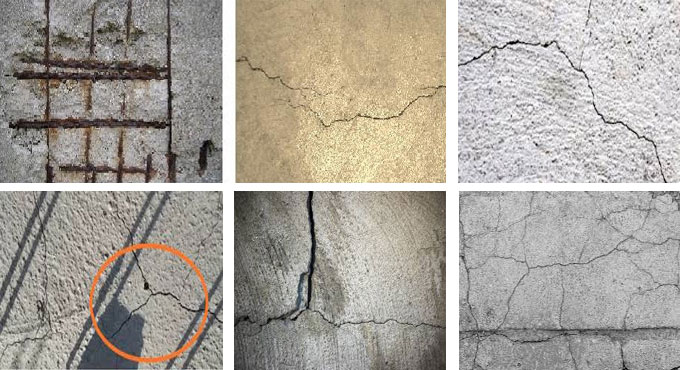
How to Prevent Cracks in Slabs
As buildings get older, they start signs of various wear and tear. Development of cracks in slabs is a common such example. This can become very dangerous if left unattended. So, today we will tell you how to prevent cracks in slabs. It can be done either by taking precautions before construction, or by doing repairs and placing supports when cracks appear in slabs.
Buildings with RCC frames start deteriorating within 15 years of construction. The concrete starts developing cracks or spalling. This isn?t ideal since the design life of the house is expected to be around 30-40 years, at least.
While there are many kinds of defects that can generate in a building, cracks in slabs can be the worst. The reason for this is the repair or maintenance cost of cracked slabs can be very high. Furthermore, the cracks in slabs act as an opening for water and chemicals inside the structural member, corroding it from within.
Reasons for Cracks in Slabs
There are many reasons why cracks should develop in a slab. Most of them are covered in the points below.
- Improper design of concrete mix.
- Improper placing practises of concrete.
- Drying and shrinkage cracks of fresh concrete.
- Cracking due to chemicals within or without.
A. intrinsic sulphate attack
B. alkali-aggregate reaction
C. incompatibility of different concrete ingredients.
- Cyclic loading and alternate wetting/drying (weathering action).
Therefore, the most important way to prevent cracks in slabs is to create them properly in the first place. Increasing durability in slabs is the best way to achieve this. This can be done if you select the right materials, and use best construction practices while building the slab.
Creating Durable Slabs
As we?ve mentioned above, the better the durability of concrete, the better off the slab will be in terms of cracking. You can increase the durability of slabs in the following manners.
Selecting the right quality cement
- Select low heat of hydration cement, and it should be impermeable after setting.
- PPC (Portland Pozzolana Cement) cement is good for this work, but it takes a long time to set.
- Adapt your design grade to utilize PPC.
- For quick construction, use OPC (ordinary portland cement), but use at least grade 53 OPC.
Make the perfect aggregate
- Concrete grade should be chosen to ensure there will be the minimum amount of voids in the concrete, and maximum strength will be achieved.
- Choose a mix of 20 mm and 10 mm aggregates. The larger chips will provide strength, and the smaller ones will pack the concrete better, minimizing voids.
- No more than 5% deleterious material.
- Fine aggregates should not have salts in them.
- Less than 3% silt in river sand.
- Fineness modulus should be between 2.6 to 3.
Mix the concrete properly
- Test moisture content of the concrete mix frequently. Keep the perfect water to cement ratio.
- Avoid adding extra water at the cost of workability. This weakens the grade.
- To increase workability, you can use chemicals instead of water.
Place proper formwork for slabs
- Formwork should remain rigid.
- Formwork for slabs should be water-tight to prevent loss of cement slurry.
- The concreting side of the formwork should be coated thinly with a quick release agent.
- Monitor the formwork constantly for leakages and choke it up as soon as it appears.
Place best reinforcements
- Tie up the rebars properly. They should not move around.
- Maintain proper spacing between bars.
- Alternate bars should be extended 0.3 times the span to the adjacent slab.
- The upper reinforcement mat should be supported using steel chairs and edge U-bars.
- The lower reinforcement mat should be supported on cover blocks.
- Stagger the laps in different bars properly as per your building code.
Waterproof the slab while casting
- Use special waterproofing chemical agents to make the slab impervious to water when casting.
- There are different types of waterproofing admixtures available to reduce the porosity of concrete - crystalline, hydrophobic & powdered/filler.
Place the concrete slab properly
- Casting should not be done under rain, in extreme hot or cold.
- Cover the freshly cast slab with gunny bags and moist them - this prevents plastic shrinkage cracks.
- Start curing as soon as possible - don?t let the slab dry completely before curing.
- Check internal conduits for plumbing and electricals for leaks before casting. Seal up any joints properly.
- Finish placing the concrete within 90 minutes. Try to do it as fast as you can.
- Place each batch against each other.
- Start placing concrete at the edges and work inwards.
- Place the concrete in small heaps and level them to fill up the cage. Don?t make large piles you have to move.
- Don?t dump the concrete from a height. Dispose it near to the formwork (from less than a meter above).
Use best practices in compaction
- Shake the concrete well to remove any voids, air gaps, honeycombs etc.
- Use needle vibrators where the reinforcements are densely packed.
- Pay special attention to joints and edges.
Provide a good surface finish
- Level the surface using a screed, wipe off any excess concrete.
- Finish the surface with a wooden float or rake, as close as possible to its final plane.
- For most slabs, some sloping should be provided (about 1 in 45).
- Check for leakages after setting, and fill any found with grout.
- Don?t start finishing the surface until all the water on the surface has dried off.


